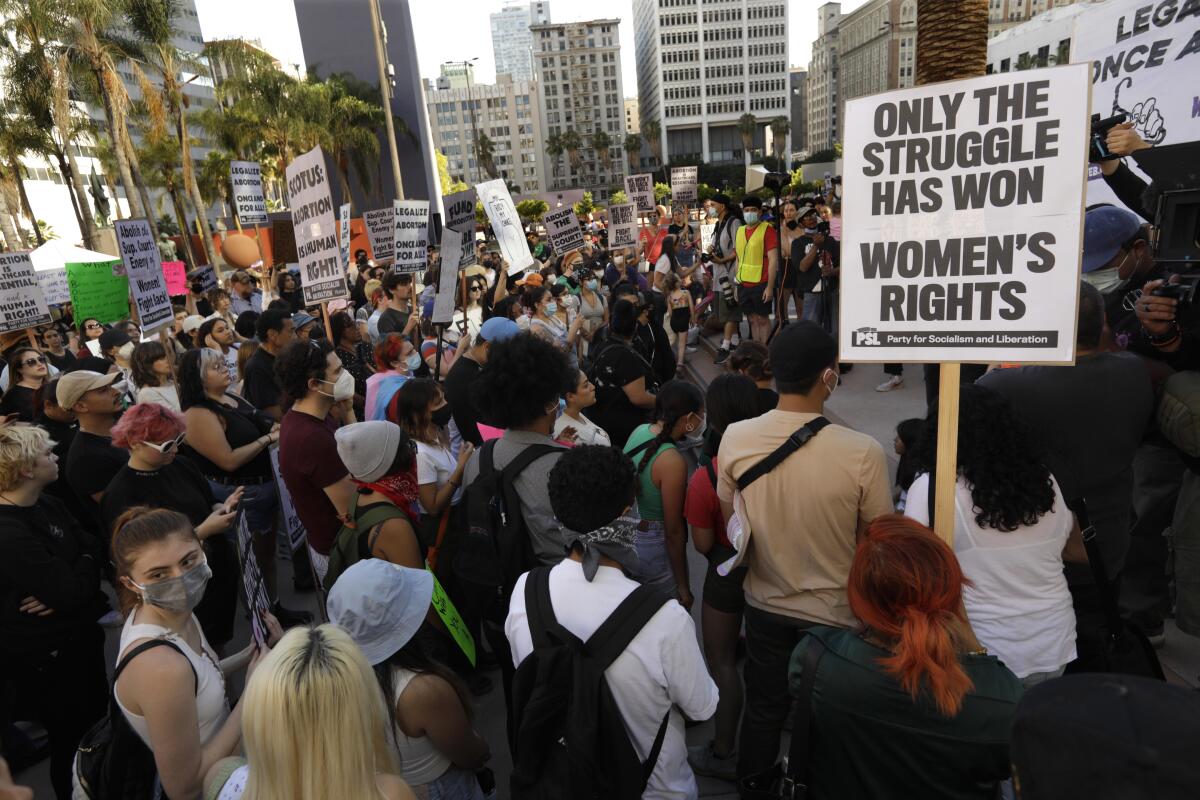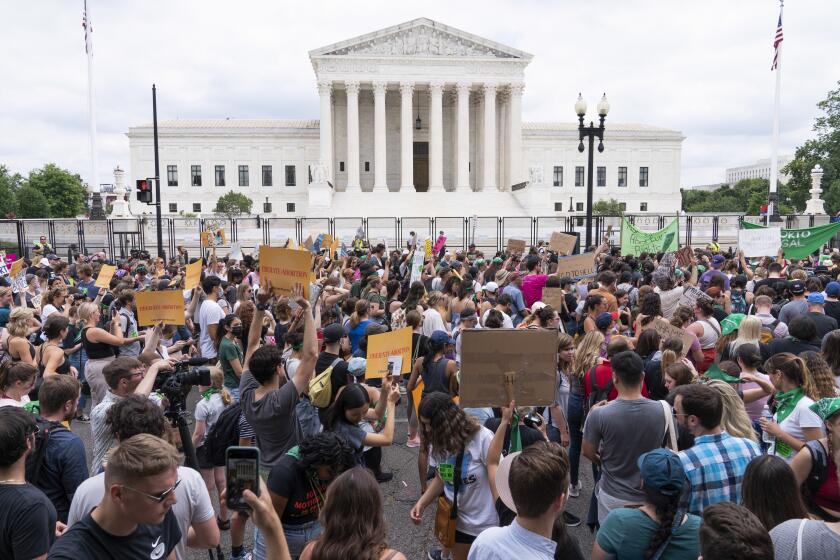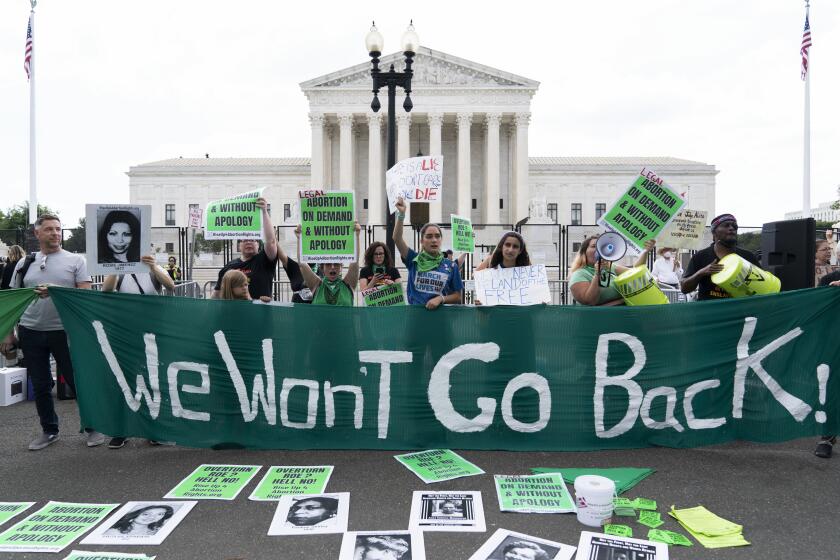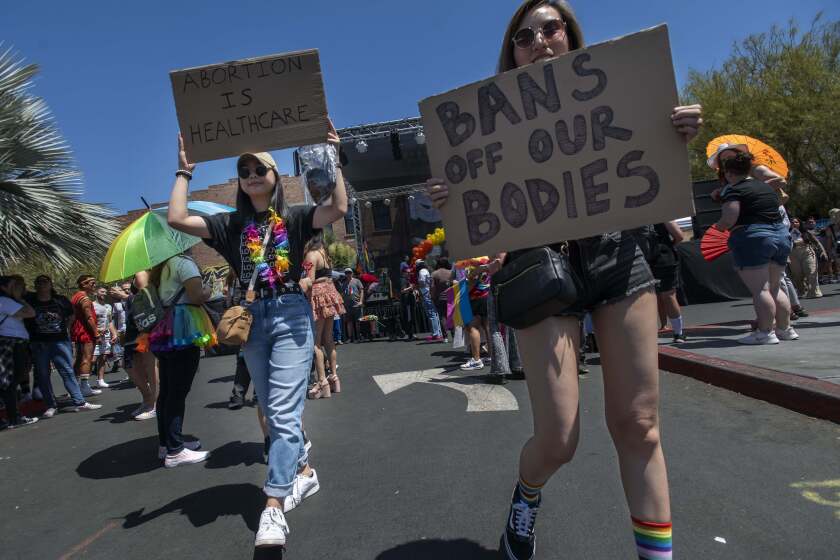Op-Ed: How to move forward after the destruction of Roe vs. Wade

- Share via
There are virtually no precedents in American law in which a right — declared fundamental by the Supreme Court — was erased. While the court has overhauled constitutional protections before, the complete retraction of the right to abortion sets the nation on a course it has never seen.
From 1910 to 1937, the court recognized a right to freedom of contract, but this rarely functioned as a liberty for workers — often, the court used this “right” to strike down laws protecting workers. And in the 1970s, four years after ruling that the death penalty as applied in the U.S. was unconstitutional, the court reinstated capital punishment after states revised their laws to meet the court’s requirements, leading to the executions of more than 1,500 people in the decades since.
But the court has never so clearly recognized a constitutional right and then simply wiped it away.
Roe vs. Wade was overruled not because of anything about its reasoning, but because Donald Trump was able to appoint three justices to the court who would end abortion rights.
That this right belongs to women is no accident. The court’s opinion in Dobbs vs. Jackson Women’s Health Organization says almost nothing about equality for pregnant people — Justice Samuel A. Alito Jr.’s majority opinion rejects arguments about abortion and sex equality in a single paragraph. It hints that striking down the right to abortion will be unpopular, and perhaps dangerously so. But the conservative justices made it quite clear that it is not their job to worry about what the public thinks. If most Americans did not want this to happen, the court quite simply does not care.
We often think of courts as expanding rights — such as protection from racial discrimination in public schools in 1954, or the right to use contraception in 1965, or marriage equality in 2015. It might be no surprise that when we think of the protection of rights, we tend to think of courts.
But the rise and fall of Roe tells a more complicated story about where our rights come from, and what we can do to defend them.
The maternal mortality rate for Black women is already three times as high as for white women. Expect that disparity to grow.
Historically, the Supreme Court has almost never acted in a vacuum. The decisions we attribute to the court, good or bad, have come in the middle of broader social movement mobilizations, with strategies that unfolded not just in the courts but in the legislatures and on the streets.
There would never have been a Brown vs. Board of Education, the landmark school desegregation decision, without the civil rights movement. Arguably, the Civil Rights Act of 1964, which sought to root out workplace discrimination, set out rights as fundamental as the one protected in Brown.
There never would have been a Roe vs. Wade without the women’s movement and the broader abortion-rights movement that it helped to fuel. Feminists held speak outs and told deeply personal stories about abortion; people marched and lobbied state legislatures. Doctors chafed under laws that they already disobeyed.
In his majority opinion in Roe, Justice Harry Blackmun points to this social upheaval and suggests that the court’s reasoning — in articulating a constitutional right — rose above the political fray and might settle broader conflicts about abortion.
The Dobbs opinion will be devastating for American lives, and it will be derided by legal scholars.
Blackmun’s view of rights, one centered on the court, has had tremendous power, but this court-centric view was never the complete story.
The view of Roe the public knows best now — one centered on women’s rights — was not articulated by the Supreme Court in 1973. At that time, the justices focused as much on the rights of doctors as on the rights of women. Feminists promoted a different interpretation of Roe, one based on self-determination for patients, that caught on with the public, with politicians, and with the court.
When the court preserved abortion rights in the 1992 case, Planned Parenthood vs. Casey, the court’s majority and the dissenters almost certainly responded to decades of battles about abortion by trying to balance the interests of pregnant people in autonomy and equality against the government’s interest in protecting fetal life.
And Dobbs itself was not the work of the Supreme Court alone — there has been half a century of work by the antiabortion movement to change the Republican Party, rework the way campaign spending works, and make sure that a different kind of justice was nominated to the Supreme Court — one who was more conservative, more ideologically committed, and less afraid of controversy.
The court tells us that Roe short-circuited our fight about abortion rights because the justices themselves wanted to have the final word. Quoting the late Justice Antonin Scalia, Alito writes that Roe “fanned into life an issue that has inflamed our national politics in general, and has obscured with its smoke the selection of Justices to this Court in particular, ever since.” Many will accuse this increasingly unpopular court of doing the same thing. But the reality is that our rights have never just come from the court, and that won’t change now.
Whether people in America can access abortion will not depend on six conservative justices. It will depend on the support progressive states provide, the ingenuity of people who support abortion access, and the ability of conservative states to shut down those avenues.
Whether there is a right to abortion, too, will depend on all of us — whether there is a progressive movement large and committed enough to match what conservatives have accomplished in changing a political party and the court. And whether that movement is operating in a country democratic enough to respond to popular will.
For decades, polls have shown that a majority of Americans did not want abortion rights to be eliminated. Now, we will see what they are willing to do about it.
Mary Ziegler is a professor at the UC Davis School of Law and the author, most recently, of “Dollars for Life: The Anti-Abortion Movement and the Fall of the Republican Establishment.”
More to Read
A cure for the common opinion
Get thought-provoking perspectives with our weekly newsletter.
You may occasionally receive promotional content from the Los Angeles Times.













